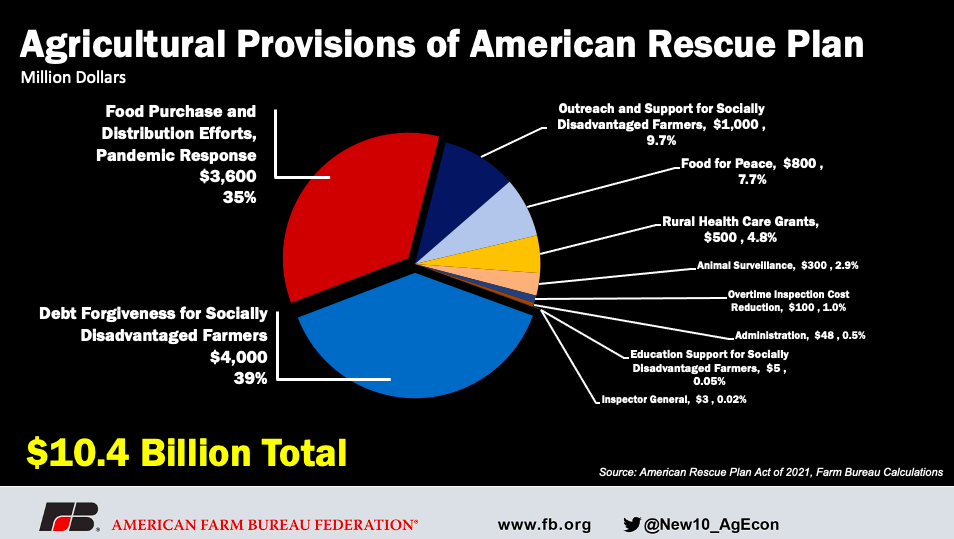What’s in the American Rescue Plan Act of 2021 for Agriculture?
TOPICS
Covid-19
photo credit: Getty Images
John Newton, Ph.D.
Vice President of Public Policy and Economic Analysis
In early March the Senate passed, on a party-line vote, the $1.9 trillion COVID-19 relief package (The American Rescue Plan Act of 2021). The legislation goes back to the House – likely this week – before it can go to the White House for final approval. While much of the coverage of the legislation has focused on the $1,400 stimulus checks for qualifying individuals, extended unemployment benefits, a moratorium on evictions and foreclosures and increased assistance through USDA’s Supplemental Nutrition Assistance Program, there are several agricultural-related provisions.
Combined, the nutrition and agricultural provisions are estimated at $22.7 billion. Today’s article reviews the agricultural provisions of the American Rescue Plan Act of 2021.
Agricultural Provisions
Agricultural provisions of the American Rescue Plan Act of 2021 appropriate an estimated $10.4 billion for programs designed to strengthen the agricultural and food supply chain, e.g., animal surveillance or COVD-19 mitigation efforts for agricultural workers; additional resources to purchase and distribute agricultural commodities to nonprofits, restaurants or other food-related entities; increase access to health care in rural communities; and provide debt relief and other support programs for socially disadvantaged farmers and ranchers.

Food Supply Chain and Agriculture Pandemic Response
The act appropriates $3.6 billion, approximately 35% of total agricultural expenditures, for USDA to purchase and distribute agricultural commodities and fund COVID-19 mitigation efforts for agricultural and supply chain workers. Similar efforts through the Farmers to Families Food Box program have resulted in the delivery of over 140 million food boxes including dairy products, fluid milk, fruits, vegetables and pre-cooked meats. This package differs in that the food donation efforts are now expected to also include other distribution channels such as restaurants and food-related entities that can receive, store, process and distribute food items.
Other efforts to protect the food and agricultural supply chain include $300 million for animal monitoring and surveillance efforts for the incidence of SARS–CoV–2. For example, mink and cats are more likely to expose humans to the viral strain that causes COVID-19 in humans. Another $100 million is appropriated to reduce fees associated with overtime inspection costs at federally inspected small and very small meat, poultry and egg processing facilities.
Assistance for Socially Disadvantaged Farmers
While the American Rescue Plan Act of 2021 does not appropriate funds directly, it’s estimated that $4 billion will be used to provide direct payments of up to 120% of a socially disadvantaged, e.g., Black, Hispanic, Native American or Asian American, farmer’s or rancher’s outstanding debt as of Jan. 1, 2021. The loans include USDA Farm Service Agency direct farm loans, USDA guaranteed loans and Commodity Credit Corporation farm storage loans, among others. The additional 20% is intended to pay off the taxes associated with the amount of the direct payment related to the outstanding debt.
In addition to the debt forgiveness, the act appropriates $1.01 billion to provide outreach, training, education, technical assistance, grants and loans, and funding to educational institutions to help improve land access for socially disadvantaged farmers and ranchers and address heir’s property issues, among other issues. In total, more than $5 billion is expected to fund provisions designed to provide assistance for socially disadvantaged farmers or provide debt relief for these farmers and ranchers.
Food for Peace
To address hunger, food insecurity and support humanitarian efforts around the world, the American Rescue Plan Act of 2021 provides $800 million to the Food for Peace program. During fiscal year 2018, the Food for Peace program provided U.S. food-in-kind, procured local food supplies, provided food vouchers and made cash transfers to more than 76 million beneficiaries in 59 countries.
Rural Development Grants for Rural Health Care
The act provides $500 million for a variety of rural health care efforts, including but not limited to increasing capacity for vaccine distribution, improving access to medical supplies, increasing telehealth capabilities, supporting staffing needs for vaccine distribution or COVID-19 testing and providing nutrition assistance to vulnerable communities.
Summary
On March 6, the Senate passed, on a party-line vote, the nearly $2 trillion American Rescue Plan Act of 2021. Along with more direct payments to eligible Americans, extended unemployment benefits and a moratorium on evictions and foreclosures, the package includes billions to boost nutrition assistance programs and improve access to food supplies in the U.S. Nutrition and agricultural support is estimated at $22.7 billion.
For agriculture, more than $10 billion is appropriated to purchase and distribute agricultural products such as fresh produce, milk and dairy products, seafood, eggs, and meat to individuals in need domestically and abroad, assist in COVID-19 mitigation efforts for agricultural workers, improve rural health care, and provide debt forgiveness for socially disadvantaged farmers and ranchers.
The legislation now returns to the House for consideration and a vote, before heading to the White House for final approval.
Top Issues
VIEW ALL